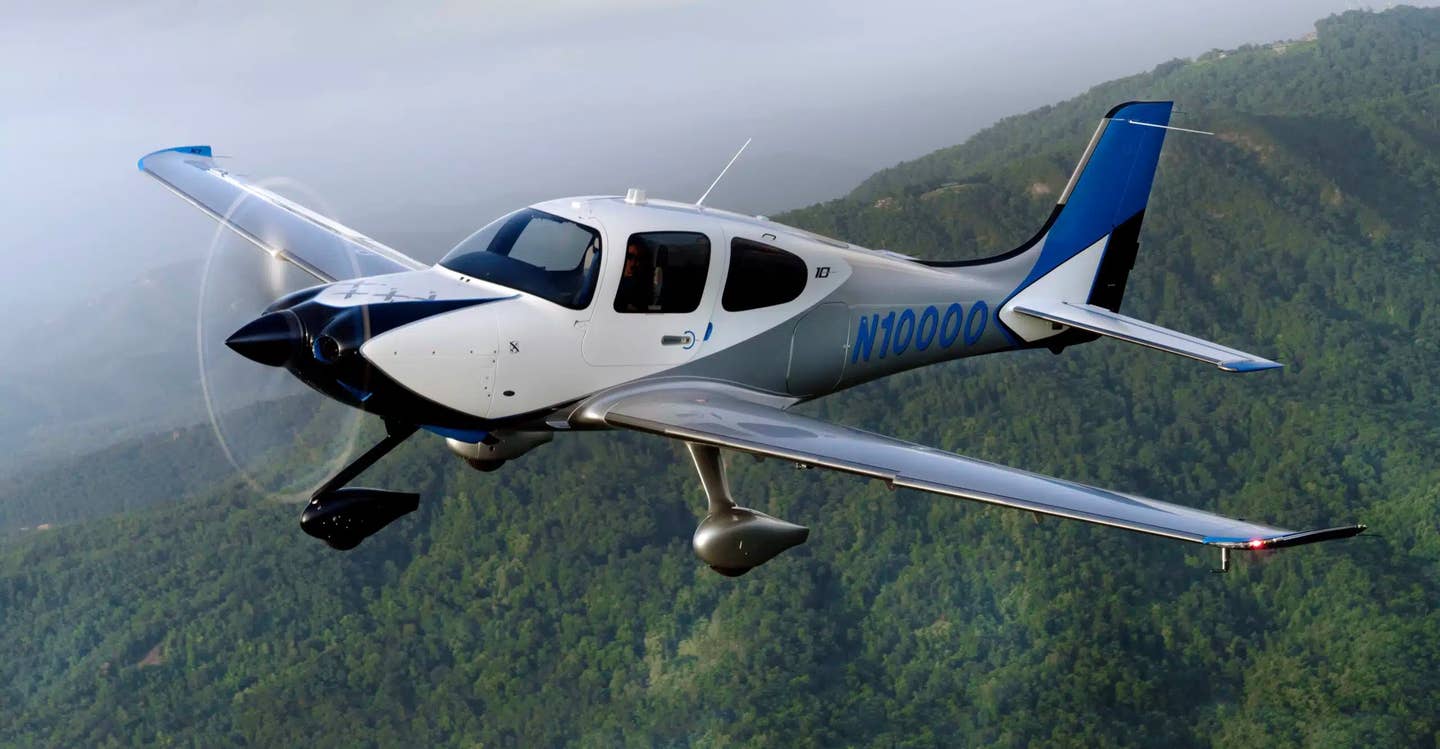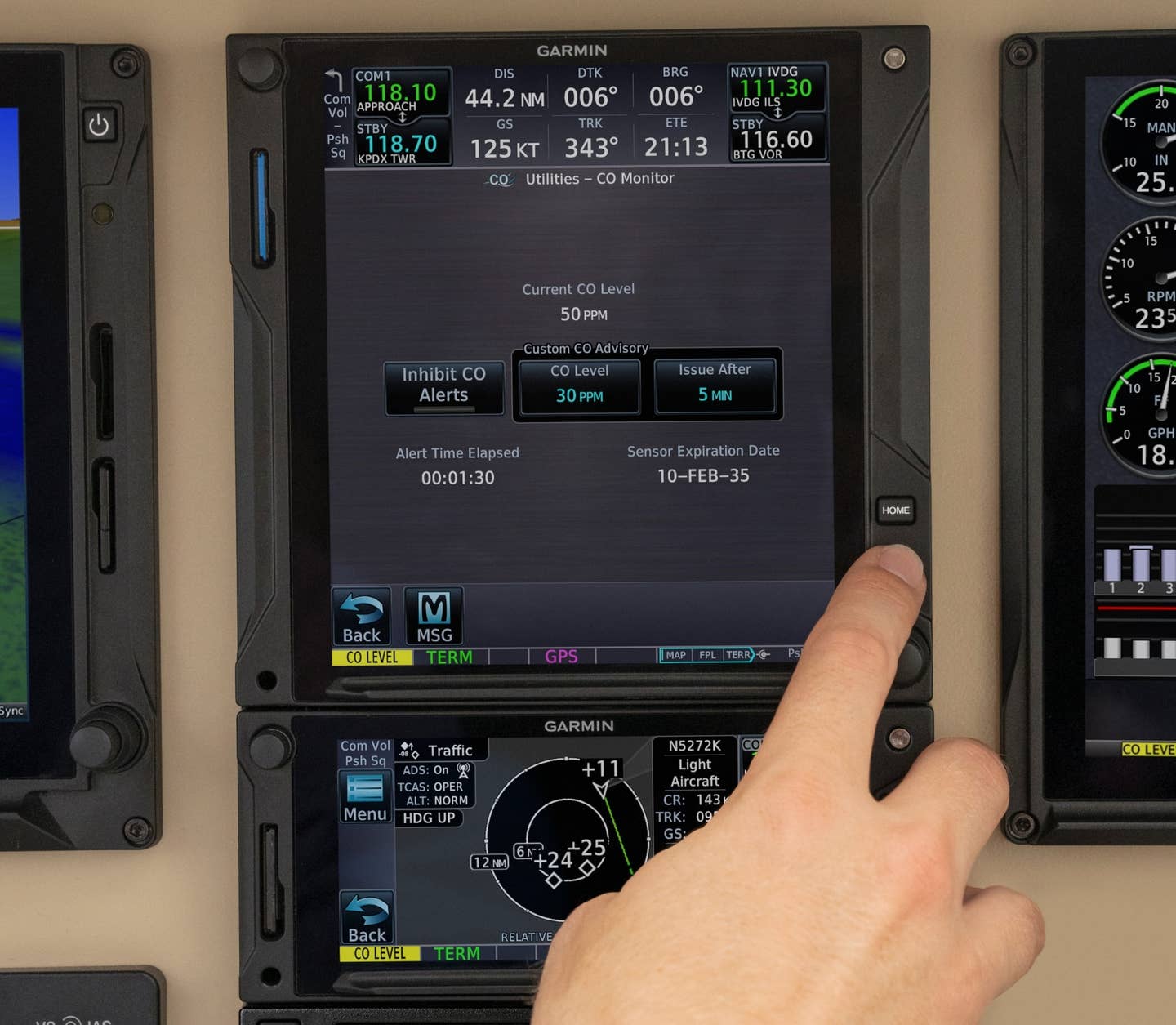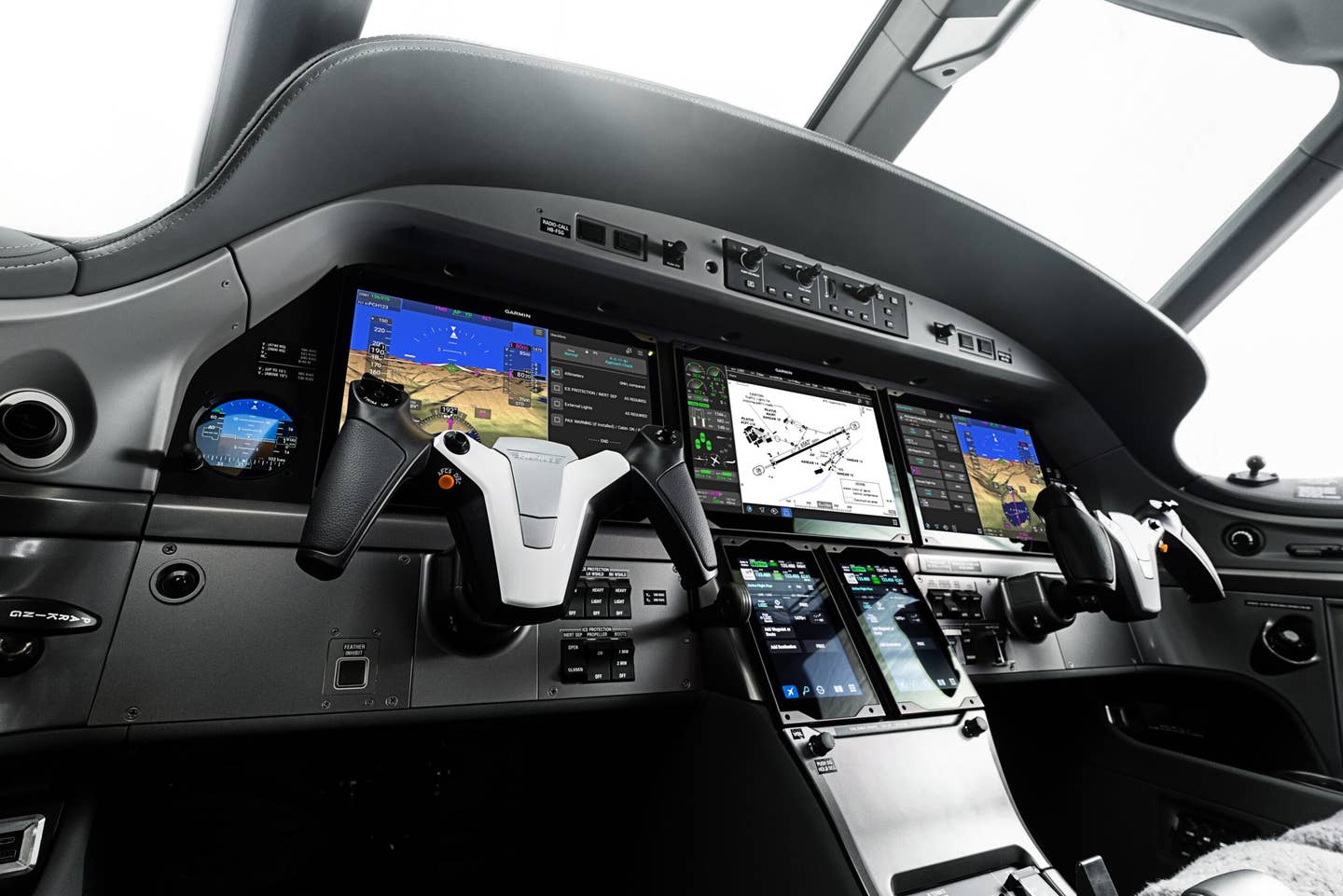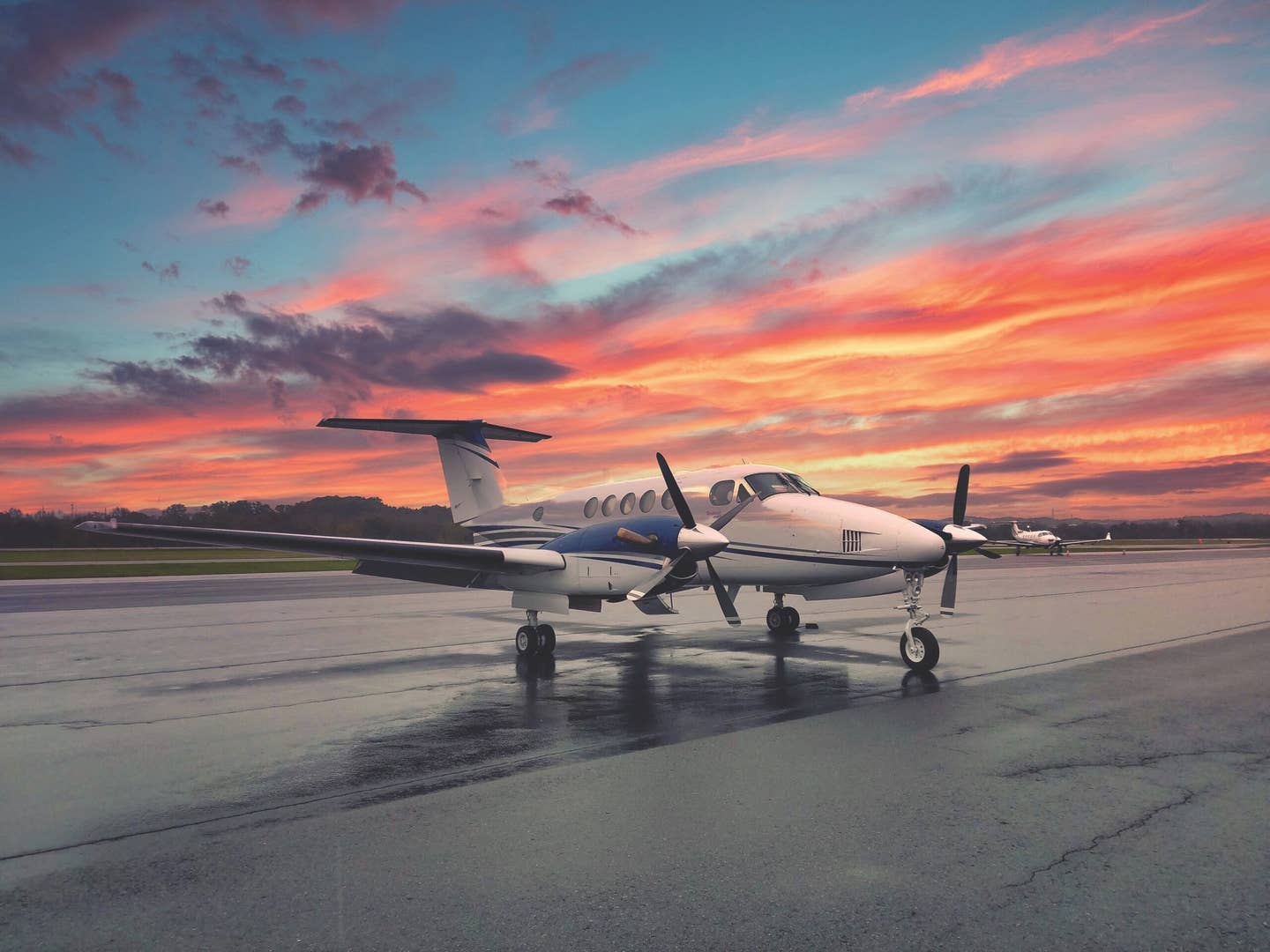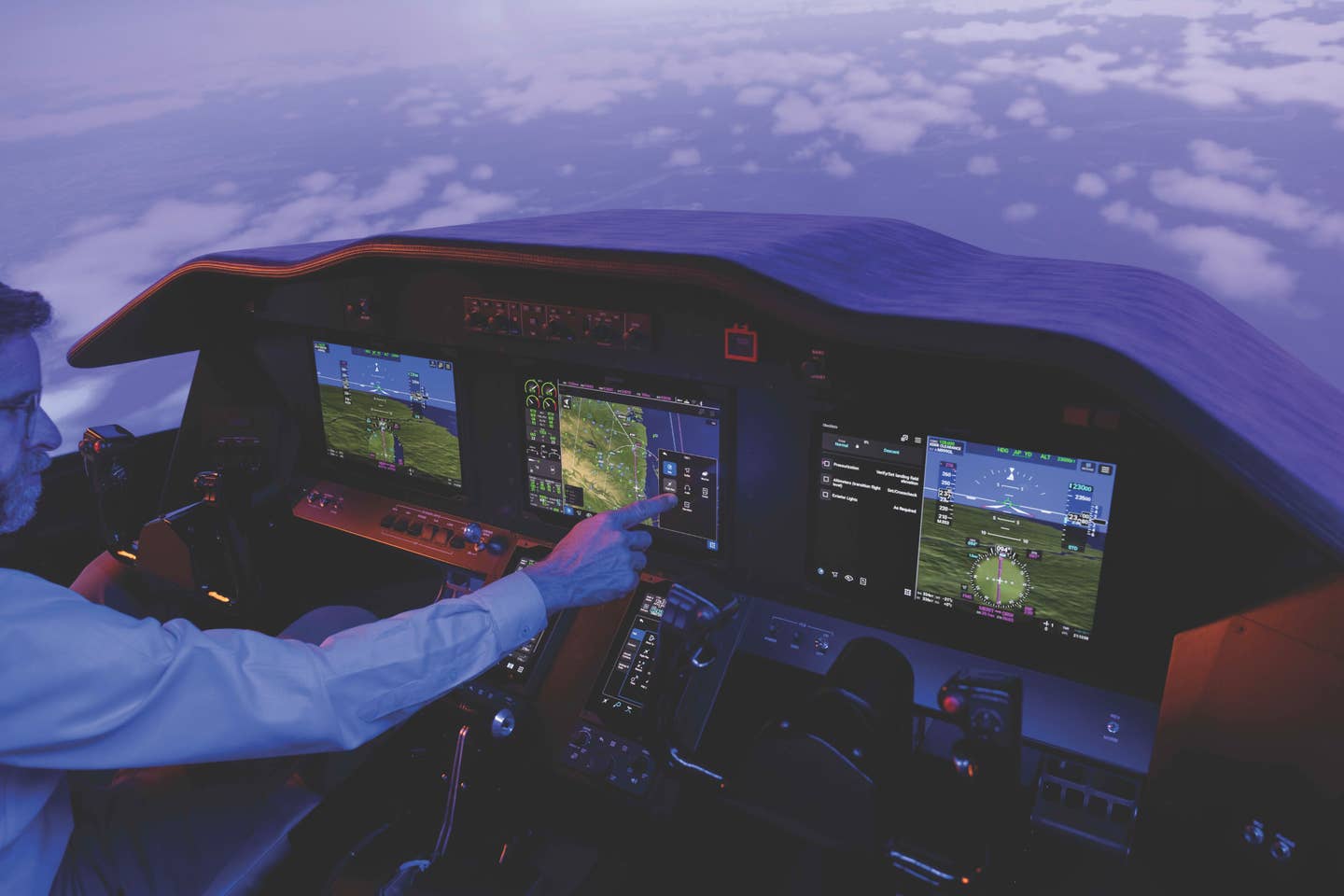Garmin: Into the Layers
Like most OEMs, Garmin embodies its product development in a “skunk works” of sorts, but few avionics manufacturers are as vertically integrated—from concept to fulfillment—under one roof.

[Illustration by Carlo Stagna]
For someone accustomed to the sounds and vibrations of an aircraft factory, the quiet hum feels nearly imperceptible at first. The industry surrounding you takes place in vignettes, where one person sits in front of an autoclave, another pirouettes fingers around an electrical board, and still another checks the tiniest bits of solder as they line up in place.
And robots join human hands. One twists around an assembly, articulating in Muppet-like motions. Another tests the next assembly by dunking it over and over into a bath—be it electrolyte or another kind of liquid: water. A third traverses the floor taking one basket to another point on the assembly line.
After all, it is a production line—but it takes a while to mentally place all of those elements on your first walk through. There are layers that unfold before your eyes, if you observe how the pieces come together. And that’s just on a single floor of a single building within Garmin International’s expanding physical plant.
More lies beneath. Much more goes into those black boxes we now follow into the clouds, into the night, along the airways to a destination. Arrows along the high ceiling replace the magenta line—but only for a moment—as you step into an atrium in the building on Garmin Way, within the Garmin Aviation complex in Olathe, Kansas.
Nearly 20 years ago, Garmin introduced the G1000 integrated flight deck to the market, with its first OEM installation in a 2003 Cessna 182—an every-pilot’s avionics suite into an every-pilot’s airplane. While not the first large-format primary multifunction flight displays to hit the certified light GA space—an honor that goes to Avidyne in the Cirrus SR20—Garmin turned that idea into a foregone conclusion by putting its consumer electronics engineering force behind it. Now, just about every new airplane flies with glass up front.
The growth continues. Garmin’s latest manufacturing and distribution center—completed in October 2018—added more than 775,000 square feet to the company’s footprint in Olathe. And it’s only the first part of a $200 million expansion. Garmin’s plans for those additional facilities—a conversion of warehouse space into a 544,000-square-foot aviation visitor’s center, plus research and development areas and employee amenities—were put on hold during 2020 but resumed in August 2021.
As we follow the path within Garmin’s headquarters taking the G1000’s latest models from concept to distribution, the OEM's engine shows no signs of letting up.
Skunk Works
Like most OEMs, Garmin embodies its design development in a “skunk works” of sorts. For now, those are found on the main floor of the facility that Garmin folks call Building 1. Coincidentally, Building 1 sits adjacent to the contemplative garden outside, where co-founder Gary Burrell’s Kansas roots meet cofounder Dr. Min Kao’s Taiwanese-American heritage in the tall prairie grass and reflecting ponds.
Garmin’s R&D space opens up from a lobby filled with a handful of prototypes from across the company’s verticals—the fitness and outdoor segments together account for nearly 60 percent of the company’s revenue, $2.4 billion in 2020. About 10 tactile and enticing prototypes of a new design, molded in black casing, sit under a poster heralding the latest inReach satcom device, and there’s also a scooter with cut ting-edge tech for motorbikes across the room.
There’s a vaguely Italian feel to the level of high design on display. Form intersects with function here— and clearly, this part of the team is inspired to play during their working hours.
One of the most curiously compelling rooms is within the Industrial Design area—and it isn’t the secret lair where the real forward-construct happens (I get the sense that those machinations remain mostly mental, interior, and seldom seen). It’s the room where the company builds and stores all of its kiosks for demo and trade shows. Because here, lined up in row upon row, sit the Garmin Aviation product evolutions, where you can compare them side by side, and follow those lines of thought.
Stephen Waite, industrial design manager, lights up a kiosk for us, in order to demonstrate the effort that goes into these deceptively simple display stands. I recall the time when Cessna Aircraft Company was spec’ing out desktop kiosks housing the G1000 avionics suite to deliver to flight schools and dealers for product tutelage and flight training. Folks around those affiliate networks expressed surprise that a kiosk would cost $18,000—when the whole enchilada installed in the business end of an airplane cost just over twice as much, roughly $45,000.
Couldn’t they be made less expensively? Just like an aircraft mockup costs as much—or more—than producing a live airframe, it’s difficult to “dumb-down” a flight deck and still have it function in a realistic way for training. The same holds true for the marketing displays produced here.
Main Lines
Our walk through the main production area in the manufacturing center begins with the donning of PPE—but in this case, we’re protecting the production environment from foreign object debris, our stray fibers and other FOD that would insinuate themselves into the tiny nooks and crannies of the sensitive avionics built on these floors.
We put on smocks and special shoes, or booties, that hold in the detritus we might redistribute as we walk around. With the masks still in place for COVID-19 protocols, along with safety glasses familiar to most manufacturing floors, I feel suited and booted for the tour.
My first impression? There are racks and racks of hardware lining multiple areas within the space—and it’s difficult to knit together where any one piece of avionics begins its journey from an assemblage of parts. But it’s easier to see where they come to conclusion: near the exit door where they pass from quality control into the distribution area of the building.
Jim Mazurek, vice president of aviation operations and distribution, led us around, allowing us to roughly follow the line along which an integrated flight deck, or navigator, or electronic instrument travels, winding through the organized pods of people and machines as they transform delicate parts into avionics that can withstand the environment inside an airplane or helicopter. Where there are robots at work, they have names—like Art and Jack—and feel almost endearing as they go about their programmed effort.
The company regularly tops consumer lists for product support, and one of our final stops in this area took us to the space Garmin uses for servicing repairs. The work requires testing, troubleshooting, and attention to detail in a different way than the other positions on the floor. I gained a new respect for the effort required to understand the issues leading to a component failure—and how that knowledge could be brought back into the manufacturing process by its proximity.
Electrifying—and Radiating
Seeing the repair stations, for me, then begged the question: How does the company ensure its components stand up, as best they can, to the abuse we give them in flight? Well, once a prototype—or several—have been built of a given model, the fun stuff begins: A series of testing regimes ensure the hardware (and the software on board) can stand up to the harsh environments that we put the components through.
To add to its alluring and compelling nature, just about all of this in-house testing takes place back in the basement of Building 1. We started our journey through this part of the Garmin complex in the area where the company conducts its electromagnetic compatibility (EMC) and interference testing.
I’ve seen videos of airframes going through lightning test programs—but I hadn’t considered before the entire laboratory needed to house radio and other electromagnetic tests, where a serious collection of Garmin gadgets undergo repeated cycles of high, medium, and low frequency electromagnetic emissions and other invisible waves of strife.
Within a sealed room, a table the size of a sandbox was filled with wire bundles powering and connecting various avionics components. Shadowing over it hovered an array composed of triangular reflectors that took up half the room’s airspace.
Inside another sealed room, the engineers assigned here conducted similar tests using vibration and other sound waves, all in the interest of determining that those black boxes could soldier on in the face of any potential onslaught as they trip through the atmosphere.
Praf Patel, senior team leader of EMC engineering, explained to us the tests in progress, and we stood quietly for a few moments, to appreciate their silent industry.
Destructive Testing
The folks having the most fun? The destructive testing lab gurus found in the Agree/Reliability labs within Garmin. We walked through the labs with Mitch Rausch, quality manager, who certainly looked like the kind of guy who not-so-secretly enjoys his work.
Mazing through the corridors, around a corner from the EMC labs, you find destructive testing labs, where a serious amount of damage is inflicted (or attempted) upon samples of each piece of the equipment Garmin ships. Dunking that’s reminiscent of a bad day at the carnival. Saline shocks worse than a bad day at the beach. Hammer drops that make for just a bad day, period. If you can think of a way Garmin should beat upon its hardware before sending it into your instrument panel, they’ve likely already thought of it, and some lucky engineer is overseeing that effort right now.
The Human Factor
The last kind of testing isn’t nearly as “hey, watch this” worthy—it’s much more of a mental game. That’s the human factors testing area, where simulators reign, and the physically tested avionics go through motions that are just as critical to safe flight.
Joe Komer, technical lead, aviation systems and human factors engineer, led us around the simulator room and then into the main sim bay, where he had a specific installation set up in the extensive fixed-base simulation platform. We strapped into the nominal flight deck of a Cessna Citation Longitude (my first go at the super-midsized jet) and focused in on the G5000 suite that makes up that airplane’s front office. The sim can be configured to match the wide range of aircraft that Garmin targets with its various product lines, and then updated as those components evolve.
Bringing It Home
Fulfillment fascinates me as well. And in the current landscape, a company such as Garmin has to hold its own within both the incoming supply chain and outgoing distribution—and connect with the likes of Amazon while retaining its in-house capacity for delivering its product to customers.
Garmin’s on-site warehouse and distribution area is divided into a couple of sections—one to serve its aviation customers and dealers directly, another to service Amazon orders and other channels for the full line of Garmin products.
Robots move some products from the ceiling-high stacks, and people on forklifts secure others. They track into tubs that flow past us on up-ramps, down ramps, and a near roller coaster of chutes, moving along at a measured yet sprightly rate.
Smaller orders travel on another track, picked up and held into place in slings that defy gravity somewhat, to safely move a sealed box or a carton from the conveyor belts to one of a couple of dozen delivery bays.
Mazurek pointed out those assembled shipments ready to go out the door—"This one’s going to a dealer, this one’s going to an installer”—as we cruised by, hurrying along to take in all of the action. Garmin’s aviation products consistently represent about 15 percent of its overall revenue (and did so in 2020 at $623 million, and again through 2021)—but they require special attention, as they hold a lot of people's lives in the balance.
Layers
The embodiment of how critical each layer is to Garmin’s success lies in two insights—one of which I derived during my visit, and the other on the occasion of the National Aeronautic Association’s Robert J. Collier Trophy gala in November 2021.
That evening took on a sincere and genuine shine for Bailey Scheel, senior aviation programs engineer, who led the project team responsible for bringing the multi-layered, enveloping safety architecture of Garmin’s Autoland to fruition. While Phil Straub, executive vice president and manager of the aviation division, accepted the award from the NAA, he put Scheel and that team front and center—and emphasized that hundreds of Garmin folks had worked toward Autoland’s development and deployment.
Garmin is far from the only avionics manufacturer to embody the attention to detail needed to innovate and succeed. The accomplishments of Aspen Avionics, Avidyne, and BendixKing (now within Honeywell Aerospace) come to mind—but few aviation OEMs approach the extensive vertical integration from concept to fulfillment, and retain all of this capability under one roof—almost literally. The significance of the physical layers of the company and the way they connect formed my first insight.
The second insight was a bit more subtle. After spending a full afternoon walking through each of the layers of Garmin’s physical plant, with detailed expositions from the folks leading within each group, I had a sense of that vertical integration, indeed.
At the close of our tour, we stood in the simulation room with Komer, when Straub came in to say hello in his genial and unassuming way.
He’d let each area of the division he leads speak for itself, both in the words of the team and the actions going on all around, and he just wanted to check in with us to make sure our questions were answered. Straub is an active pilot, and he’s been leading Garmin Aviation since 2011, after joining the company in 1993 as a software engineer.
But his words to us that day and again at the Collier event reflected the same philosophy—the team leads the way. It’s not about him, or any one person. You sense that he’s there as a supporter, an enabler, and a coach, leading from within the team—amongst all of those human layers. And it’s working.
Expanding the Safety Envelope
Garmin flight test engineers find new ways to assist pilots.
TWO RECENT RELEASES from Garmin, Smart Rudder Bias and Smart Glide, show the evolution of enhanced stability protection (ESP)—Garmin’s "telepathy" that kicks in to assist pilots when the airplane strays outside of normal-category operations.
In an interview with Garmin flight test engineer Joshua McKinney, I asked about how these newest safety features fit into the Autonomí suite’s philosophy. “The thing that helps people understand what is expected of the machine and what is expected of the pilot [is that] a lot of things happen up front automatically, but after that initial assistance, then nothing happens automatically,” McKinney said.
Garmin’s lead demonstration pilot Jessica Koss and I flew with both Smart Glide and Smart Rudder Bias on back-to-back days so I could understand how each played a role in expanding the capabilities of its envelope protection. Both build upon other aftermarket GTN Xi navigator features, and the GFC 500 or 600 digital autopilot, in a wide range of airplanes. Smart Glide includes the GTN’s range ring optimized for an engine-out situation. “It aviates, it navigates, and it communicates for us—partially,” Koss said. “It gives us the option to squawk 7700, for example.” If the autopilot is engaged, the sequence begins by pitching for best glide speed (110 knots in the Beechcraft A36 Bonanza we flew from Garmin’s flight ops facility at the New Century Airpark in Olathe, Kansas).
An airport glide indicator helps the pilot determine which airport to go to, setting up a direct-to course to the nearest, if one is in range, and putting the CTAF or tower frequency in the standby—or the emergency frequency of 121.5 if you’re not within gliding distance of anything in the database. “It will also tell us if the destination becomes unreachable,” said Koss, according to the data. If the airplane is less than 2 nm from the airport, the autopilot will not couple, anticipating the pilot’s prompt action instead.
With Smart Rudder Bias, the team harmonized the ESP function within Autonomí to work with a rudder assistance function in the event of a power loss in a light twin—such as the Beechcraft Baron we flew for the demonstration. Brandon Toby, initial flight test pilot, loved the challenge of developing the software. “This is the first time I’ve had to quantify engine-out performance [in such a way] and get down deep within those numbers,” he said.
The functions are there to assist pilots—not to fly the airplane for them—and to reinforce the lessons we’ve learned in training.

Sign-up for newsletters & special offers!
Get the latest FLYING stories & special offers delivered directly to your inbox

